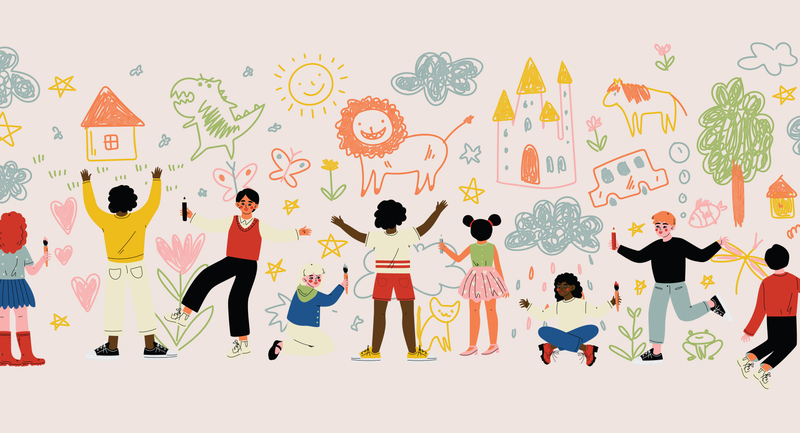Ten years ago, we began a research project by asking both teachers and students two simple questions: What kind of work do you find totally engaging? and What kind of work do you hate to do? Almost immediately, we noticed distinct patterns in their responses.
Engaging work, respondents said, was work that stimulated their curiosity, permitted them to express their creativity, and fostered positive relationships with others. It was also work at which they were good. As for activities they hated, both teachers and students cited work that was repetitive, that required little or no thought, and that was forced on them by others.
How, then, would we define engagement? Perhaps the best definition comes from the work of Phil Schlecty (1994), who says students who are engaged exhibit three characteristics: (1) they are attracted to their work, (2) they persist in their work despite challenges and obstacles, and (3) they take visible delight in accomplishing their work.
Most teachers have seen these signs of engagement during a project, presentation, or lively class discussion. They have caught glimpses of the inspired inner world of a child, and hoped to sustain this wonder, enthusiasm, and perseverance every day. At the same time, they may have felt stymied by traditions of reward and punishment. Our challenge is to transcend these very real difficulties and provide a practical model for understanding what our students want and need.
Goals and Needs: The SCORE
Success (the need for mastery),
Curiosity (the need for understanding),
Originality (the need for self-expression),
Relationships (the need for involvement with others).
These four goals form the acronym for our model of student engagement—SCORE. Under the right classroom conditions and at the right level for each student, they can build the motivation and Energy (to complete our acronym) that is essential for a complete and productive life. These goals can provide students with the energy to deal constructively with the complexity, confusion, repetition, and ambiguities of life (the drive toward completion).
Rethinking Motivation
The concept of “score” is a metaphor about performance, but one that also suggests a work or art, as in a musical score. By aiming to combine achievement and artistry, the SCORE model can reach beyond strict dichotomies of right/wrong and pass/fail, and even bypass the controversy about intrinsic and extrinsic motivation, on which theories of educational motivation have long been based.
Extrinsic motivation—a motivator that is external to the student or the task at hand—has long been perceived as the bad boy of motivational theory. In Punished by Rewards, Alfie Kohn (1995) lays out the prevailing arguments against extrinsic rewards, such as grades and gold stars. He maintains that reliance on factors external to the task and to the individual consistently fails to produce any deep and long-lasting commitment to learning.
Intrinsic motivation, on the other hand, comes from within, and is generally considered more durable and self-enhancing (Kohn 1993). Still, although intrinsic motivation gets much better press, it, too, has its weaknesses. As Kohn argues, because intrinsic motivation “is a concept that exists only in the context of the individual,” the prescriptions its proponents offer teachers, are often too radically individualized, or too bland and abstract, to be applied in classroom settings (See “Punished by Rewards? A Conversation with Alfie Kohn,” p. 13).
Perhaps it is the tradition of separating extrinsic and intrinsic motivation that is flawed. Robert Sternberg and Todd Lubart recently addressed this possibility in Defying the Crowd (1995). They assert that any in-depth examination of the work of highly creative people reveals a blend of both types of motivation.
Knowing the SCORE
Under what conditions are students most likely to feel that they can be successful?
When are students most likely to become curious?
How can we help students satisfy their natural drive toward self-expression?
How can we motivate students to learn by using their natural desire to create and foster good peer relationships?
Much of what we will discuss is already taking place in classrooms across the country. The point of our SCORE model of engagement is first to help teachers discover what they are already doing right and then to encourage the cultivation of everyday classroom conditions that foster student motivation and success.
Convincing Kids They Can Succeed
Students want and need work that enables them to demonstrate and improve their sense of themselves as competent and successful human beings. This is the drive toward mastery. But success, while highly valued in our society, can be more or less motivational. People who are highly creative, for example, actually experience failure far more often than success.
We must clearly articulate the criteria for success and provide clear, immediate, and constructive feedback.
We must show students that the skills they need to be successful are within their grasp by clearly and systematically modeling these skills.
We must help them see success as a valuable aspect of their personalities.
All this seems obvious enough, but it is remarkable how often we fail to meet these conditions for our students. Take skills. Can you remember any crucial skills that you felt you did not successfully master because they were not clearly taught? Was it finding themes in literature? Reading and interpreting primary texts? Thinking through nonroutine math problems? Typically, skills like these are routinely assigned or assumed, rather than systematically modeled or practiced by teachers.
So how can we help students master such skills? When teaching your students to find themes, for example, deliberately model interpretation. Ask your students to give you a poem you have never seen, and then interpret it both for and with them. If they are reading primary texts, use what we call the “main idea” strategy. Teach them how to find the topic (usually a noun or noun phrase), the main idea (a sentence that states the text's position on the topic), and reasons or evidence to support the main idea. If students are concerned about writer's block, remember that perhaps the most difficult task of a teacher is to teach how to think creatively. Model the process of brainstorming, demonstrating that no idea is unworthy of consideration.
These are not revolutionary ideas. They simply illustrate how easily classroom practices can be improved, thus increasing the chance that your students will succeed.
But what of the criteria for success? Teachers define success in many ways. We must not only broaden our definition, but also make sure the definition is clear to everyone. In this way, students will know when they have done a good job, and they will know how to improve their work.
To achieve this clarity, we can present examples of work that illustrate high, average, and low levels of achievement. Such exemplars can significantly motivate students, as well as increase their understanding of their own ability to achieve.
Arousing Curiosity
Students want and need work that stimulates their curiosity and awakens their desire for deep understanding. People are naturally curious about a variety of things. Einstein wondered his whole life about the relationships among gravity, space, and electromagnetic radiation. Deborah Tannen, the prominent linguistic psychologist, has spent years pondering the obstacles that prevent men and women from conversing meaningfully.
How can we ensure that our curriculum arouses intense curiosity? By making sure it features two defining characteristics: the information about a topic is fragmentary or contradictory, and the topic relates to students' personal lives.
Mammals survived the changes that killed the dinosaurs.
Chickens under stress lay eggs with thinner shells than do chickens not under stress.
While flowering plants evolved, dinosaurs increased in population and in number of species.
Some flowering plants contain alkaloids.
Students then work together in groups, retracing the steps scientists took in weighing the available evidence to arrive at an explanation. We have seen students work diligently for several days dealing with false hypotheses and red herrings, taking great delight when the solutions begin to emerge.
As for topics that relate to students' lives, the connection here cannot be superficial; it must involve an issue or idea that is both manageable and unresolved. We must ask, With what issues are adolescents wrestling? How can we connect them to our curriculum? Figure 1 illustrates some possibilities for adolescents.
Figure 1. The Curiosity Connection: Relating Content to Students' Lives
Strengthening Student Engagement: What Do Students Want - table
Adolescent Issue | Topic | Connection |
|---|
| Independence: How can I separate myself from parents and other adults? | American Revolution | When is rebellion justified? |
| The search for identity: Who do I want to be? What do I want to become? | Percentages | To determine your likes and dislikes, compute the percentage of your life spent in various activities. |
| Relationships and stature: How important are my opinions of my peers, my family? | Jane Austen's Emma | Discuss how stature and reputation affect Emma's decisions and your own. |
| Responsibility: For what do I want to take responsibility? What is expected of me? | Ecology | Investigate social organizations working to improve the environment. |
Adapted from Beane, J. A., and R. P. Lipka. (1986). Self-Concept, Self-Esteem, and the Curriculum. New York: Teachers College Press.
Encouraging Originality
Students want and need work that permits them to express their autonomy and originality, enabling them to discover who they are and who they want to be. Unfortunately, the ways schools traditionally focus on creativity actually thwart the drive toward self-expression. There are several reasons for this.
First, schools frequently design whole programs (art, for example) around projects that teach technique rather than self-expression. Second, very often only students who display the most talent have access to audiences, thus cutting off all other students from feedback and a sense of purpose. Finally, and perhaps most destructive, schools frequently view creativity as a form of play, and thus fail to maintain the high standards and sense of seriousness that make creative work meaningful.
Connect creative projects to students' personal ideas and concerns. One of our favorite teachers begins her study of ceramics by having students examine objects found in the homes of a variety of ancient civilizations. She then asks the class to design a ceramic object that expresses their feeling about their home.
Expand what counts as an audience. One of the most successful creative projects we have seen involved an audience of one. Each student in a middle school class was linked to an older member of the community and asked to write that person's “autobiography.”
Consider giving students more choice. The medium of expression, for example, is often as important to an artist as the expression itself. What would have happened to the great tradition of American blues if the early musicians were forced to adhere to traditions of European music? This is one more argument for instructional methods that emphasize learning styles, multiple intelligences, and cultural diversity.
Use the “abstracting” strategy to help students fully understand a genre and to maintain high standards (Marzano et al. 1992). Too often, students prefer video art to a book because they perceive it as less demanding or requiring less commitment. Teaching students to abstract the essence of a genre will change their perceptions.
Begin by studying examples of high-quality work within a genre (the science-fiction story, poster art, sonnets, frontier diaries, television news programs, and so on). Examine the structure of the works and the standards by which they are judged. Then, ask students to produce their own work in that genre that expresses their own concerns, attempting to meet the high standards embodied in the original work. Finally, have the students ask themselves four questions about their work: How good is my technique? Does my work truly express my own concerns? Does it demonstrate my understanding of the genre in which I am working? Does it successfully relate to its audience?
Some people worry that the stringency of this model might actually block self-expression, but our experience is precisely the opposite. Students' drive toward self-expression is ultimately a drive to produce work that is of value to others. Lower standards work to repress, not to enhance, the creation of high-quality work.
Fostering Peer Relations
Students want and need work that will enhance their relationships with people they care about. This drive toward interpersonal involvement is pervasive in all our lives. Further, most of us work hardest on those relationships that are reciprocal—what you have to offer is of value to me, and what I have to offer is of some value to you. In general, unbalanced, nonreciprocal relationships prove transient and fail to generate much energy or interest.
How does this insight apply to life in the classroom? Consider a student's perception of homework. The only relationship that can be advanced through the typical homework assignment is the one between student and teacher. And this relationship is essentially unbalanced. Students do not feel that the teacher needs their knowledge, and the teacher, with possibly 145 students a day, probably isn't seeking a deep relationship either.
But suppose student work is complementary: one student's job is to learn about tortoises, another's is to learn about snakes, and a third student is boning up on lizards. After they do their research, they jointly develop a poster comparing and contrasting these three reptile types. The students actually need one another's knowledge.
Annemarie Palincsar Brown has applied this “jigsaw” strategy to inner-city students using in-classroom computer networks (Brown et al. 1993). She found that it significantly improved their motivation, reading, and writing. Elizabeth Cohen (1994) builds reciprocal groups by asking students with different talents and abilities to work on one project that requires all of their gifts.
As teachers, the first thing we should try to “score” is our own performance. Different people value the four goals we have discussed to different degrees in different situations. Which ones are particularly important to you? How does this preference affect the way you run your classroom? By observing and understanding how classroom conditions can create or repress student engagement, we can gradually move toward a more successful, curious, creative, and reciprocal school system.
All students, to some extent, seek mastery, understanding, self-expression, and positive interpersonal relationships. But they are all different as well. Imagine what could happen if we engaged our students in a discussion of these four types of motivation. What might they tell us about themselves and their classrooms? Could we actually teach them to design their own work in ways that match their own unique potential for engagement?
Last, we can score the change process itself. What professional conditions block teachers' motivation? We can redesign staff development to promote understanding and respect among school staff members.
By seeking to break down boundaries between teacher and teacher, teacher and student, student and the learning process, we will learn what students want and need. As a result, more and more teachers may go to bed at night remembering the images of wonder, enthusiasm, and perseverance on the faces of their students.







